Bridge engineers in most parts of the world are familiar with the concept of field spliced steel plate girders. I mean, actually saying field spliced steel plate girders may not even be necessary anymore. It’s understood. Shipping built up steel shapes often gets a little hairy as they get longer, and the whole reason you use steel is because of its ability to span great distances, say up to about 400 feet for a continuous plate girder bridge. So if you can’t ship the whole thing – you splice it.
Bolted field splices in steel construction are common. So common, I’m not even going to talk about them anymore.
But what about prestressed concrete girders, what if you could splice those? Well, it turns out you can. Concrete is heavy. Certainly heavier than steel and stiffer too, so our problems with stability during shipping aren’t as much of an issue – but they are still a concern.
At some point bridge designers will be limited on what they can design, not by limitations on the materials available, but by other practical concerns. Where is the bridge? Where is the fabrication plant? What route will the truck take for delivery?
Vertical clearance. How deep is your section? How will it be bunked on the truck? Even if your record setting hunk of concrete will fit under all of the bridges along the route, what about power lines and luminaires?
Geometry. Tight radius curves, superelevation slopes that approach the famous banked oval at Monza – each can be hazardous to the transportation of a monster girder.
Weight. With more length comes extra weight. Does your area even have a trucking company with equipment capable of carrying your monster girder?
Here is one solution to this predicament – splice those girders. It is a solution that is more common than you would think. The concept is rather similar to steel. You fabricate your girders in easy to handle sticks which can be transported to your site by truck or by barge, then erected and tied together to form a continuous girder.
While similar to segmental construction, it is also distinct for a number of reasons. Segmental bridges are constructed of short segments, roughly 10 feet long. They are mainly box girder shapes, and each segment is post-tensioned to the last segment. Segmental construction uses match casting so the two segments mate up perfectly.
In a splice girder, the segments are often 100+ feet long. They are usually pre-tensioned during fabrication, generally for lifting and hauling stresses only. They are not match cast – they don’t need to be, the ends to be spliced do not actually contact during erection. Instead, a cast in place closure is used between precast segments. Post-tensioning is then completed at the end once all of the splices are made, which requires the girder to be supported during construction.
Recent advances in hauling and fabrication capabilities has led to the advent of super girders – that is girders over 100 inches tall. With these depths and the ability to transport such heavy and long single sticks, girders have now eclipsed the 200 foot barrier. But not every project can benefit from such long girders. And that is where splice girders come in, a middle distance competitor to steel plate girders and perhaps a cheaper alternative to the mighty segmental.
One notable project is the Rockingham Bridge replacement project in Vermont. The Vermont Agency of Transportation is currently working on a project to replace the twin four span steel deck trusses which carry Interstate 91 over the Williams River near Rockingham, VT. Owing to the poor condition of the existing bridges, VAOT released a Request for Proposals for a pair of new bridges to be built by the Design-Build method in late 2015.
The base technical concept was for a three span segmental box girder, similar to another VAOT project then under construction at Brattleboro. The winning design was an unsymmetrical four span post-tensioned splice girder bridge, with a maximum span length of 245 feet. As of the date of this article’s publication, the contractor is currently setting girders for the second bridge with project completion set for 2020.
The design, largely similar to the concept of the Manette bridge in Bremerton, WA, uses three haunched pier segments. These segments taper from a standard New England Bulb Tee (NEBT) shape at each end to 10 feet in depth at the center. In between these haunched pier segments are standard NEBT shaped girders, with modifications to accommodate post-tensioning ducts in the webs.
Each pier segment is 96 feet long and weighs about 180,000 pounds. Both the depth and weight of the sections had restrictions imposed by the girder fabricator which were based on trucking, lifting and headroom limitations.
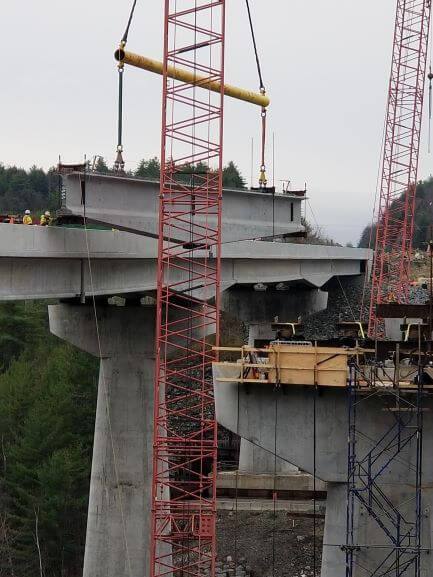
Each girder line is post-tensioned by three 19 strand tendons a piece, draped end to end following a parabolic path. Segment geometry put the splices at about 0.2L, a little short of the true point of contraflexure, meaning there is some extra negative moment to deal with. Ideally, you would put splices as close as possible to the point of no moment.
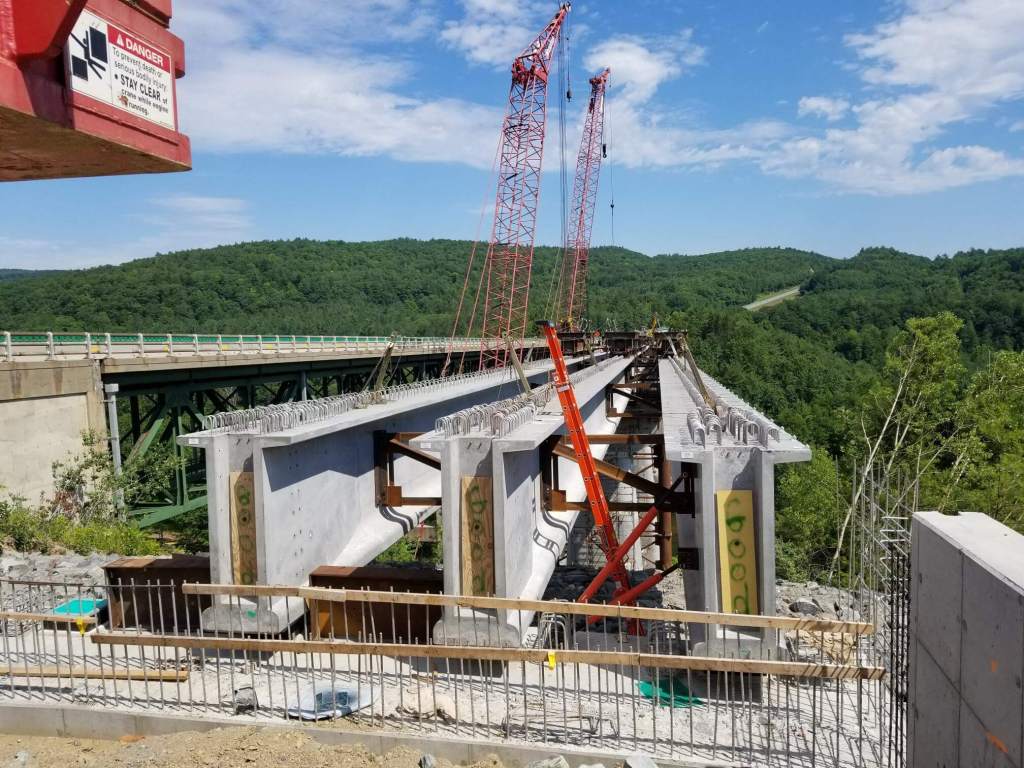
Although post-tensioned for in service loads, pre-tensioning is used to control handling stresses – such as lifting, hauling and erection stresses. In the case of the pier segment, you’re trying to haul a segment specifically designed to carry primarily negative bending moment in a positive moment configuration. In trying to satisfy hauling stresses, it is easy to over pre-tension the segment such that the final service stress allowables are exceeded. In this case it is wise to use the code to your advantage. AASHTO allows the use of higher allowable stress values in temporary conditions if sufficient mild reinforcement is added to resist the tension in the concrete.
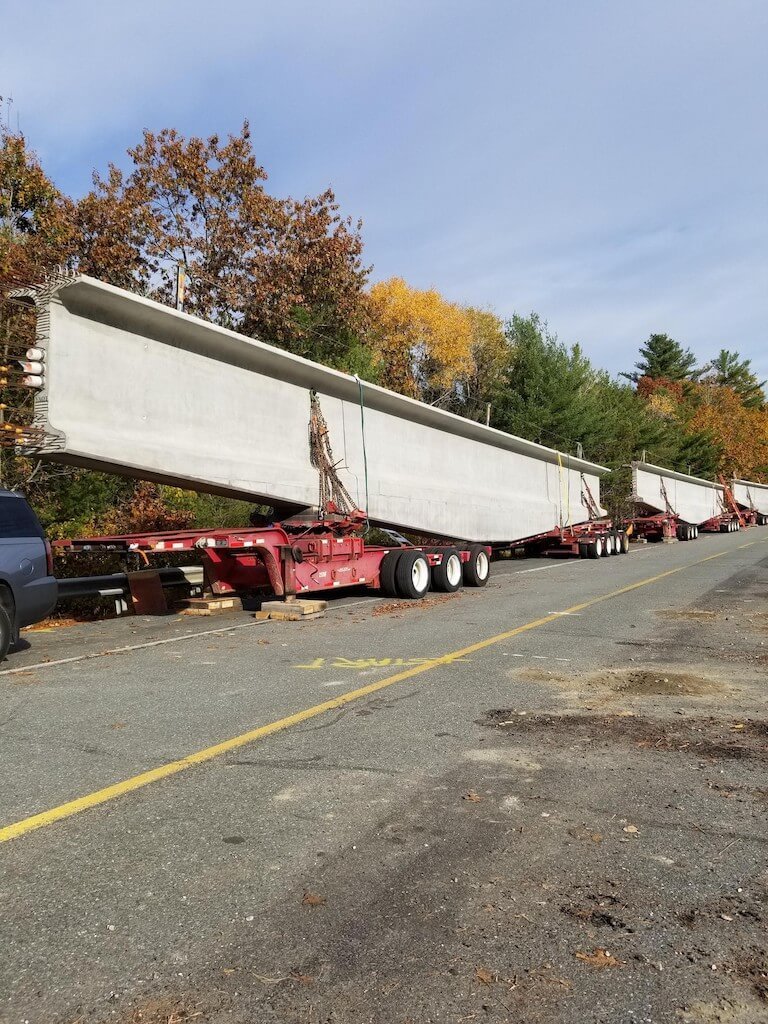
Once complete, these bridges will be the longest bridges of their type in New England.
But Rockingham is just one example of a splice girder type, which has many variations on the same basic theme. You can use constant depth sections. You can use a drop crossbeam at the pier with one or two splices per span. Post-tensioning can be end to end or it can be span by span. Any type of prestressed section can be used. The possibilities are numerous, which can make a splice girder a very attractive bridge type.
Temporary supports can cause some consternation, so use some careful thought here. On Rockingham, the unsymmetrical layout was chosen so as to utilize the existing bridge piers where possible. In some situations, terrain features may make a reasonable temporary tower design challenging. Still others have found ways to utilize the main piers for support of the girders. Brackets or “angel wings” are attached to the main piers and are used to support the pier segments.
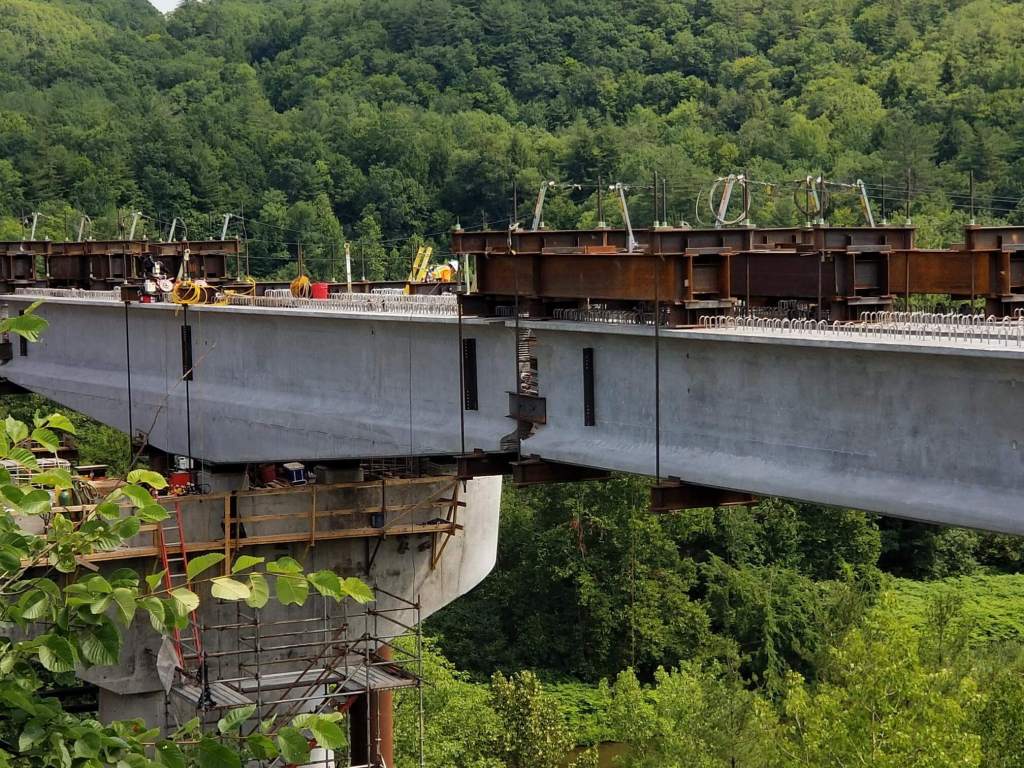
One neat trick is to use the concept of balance in your favor. With a pier segment balanced on a single pier, you only need one temporary support for stability. For setting the drop in girders, strongbacks, placed either on the pier segment or the drop in segment, can be used to further eliminate temporary supports. These hangers support the segment while transferring load through the pier segment and into the temporary support.
Even more versatile is the casting sequence. There are three main ways to design a splice girder, each with benefits and drawbacks:
Post-tension all tendons then cast the deck – this method keeps all stresses in the girders within the allowable code limits while still using the composite section to resist super-imposed and live loads. Downsides are that the deck is not pre-compressed, however the deck can be replaced in the future with little additional effort.
Post-tension some tendons, cast the deck, then post-tension the rest – this method attempts to introduce at least some pre-compression into the deck while still controlling the girder stresses within the allowable limits. The deck may not, however, be fully in compression. Downsides are the extra effort required by the designer in considering the different stages as well as additional mobilization of the post-tensioning subcontractor.
Cast the deck, then post-tension – this method provides a fully pre-compressed deck by applying post-tensioning to the entire composite girder. This can be challenging to do as the tendons may not be able to be raised as high as in the section as the other two methods, making allowable stress satisfaction challenging. Downsides are the extra post-tensioning that is typically required and the relative difficulty in replacing or rehabilitating the deck at a later date.
So how does a splice girder bridge compare on cost? While this is largely dependent on region, in general splice girders are pretty competitive with steel. However, at long spans you’ll find that splice girders tend to meet their match – but more from hauling limitations rather than technical limitations. For horizontal curves, spliced tub girders are an alternate to steel. And let’s not forget about lifecycle costs. A splice girder won’t need painting every 25 to 30 years.
The verdict, then, is that concrete splice girders offer a versatile tool for any bridge engineer’s tool belt. The bridge engineering world is only just embracing the concept and with good results. For years it seems the concept had been relegated to the niche market, but not anymore. As a challenge for the engineer, there is really no better bridge type!
Views: 4082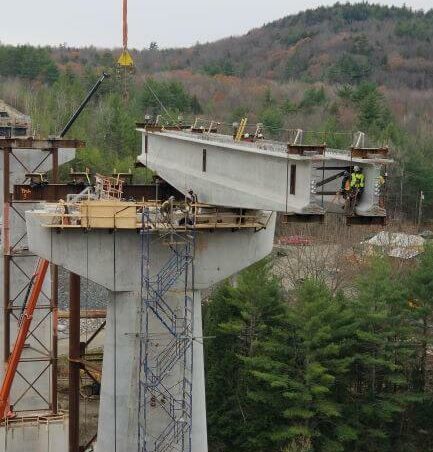

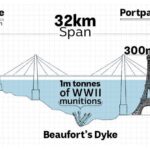





There are many things to learn, so much info on it.
King regards,
Demir Duke
Very good article, hi. I hope you will publish such sort of post.
Thank you!
King regards,
Mead Hessellund
This site really has all the information I wanted concerning this subject and didn’t
know who to ask.
I’m really happy to say it was an interesting post to read.
King regards,
Mead Raahauge
The site style is great, the articles are really great : D. Good job, cheers|
Wow, awesome weblog format! How long have
you been running a blog for? you make blogging easy.
The full look of your site is fantastic, as well
as the content material!
Thanks! This is my first foray into blogging.
Like!! I blog quite often and I genuinely thank you for your information. The article has truly peaked my interest.
Best view you can finde , in this side of world!
Hello there! This blog post couldn’t be written any better!
Looking through this article reminds me of my previous roommate!
He continually kept preaching about this. I will forward this post to him.
Pretty sure he will have a good read. Thank you for sharing!
You ought to take part in a contest for one of the highest quality sites on the net. I most certainly will highly recommend this site!
You’ve done an impressive job and our whole community
Neat blog! Is your theme custom made or did you download it from somewhere?
A theme like yours with a few simple tweeks would really make my blog jump out.
Please let me know where you got your theme.
Kudos
It was a pre-loaded theme from WordPress.
What’s up to every body, it’s my first pay a quick visit of this weblog; this website includes remarkable and really excellent information designed for readers.
I reallyhope to seethe same high-grade content by yo
I’ve read a few just right stuff here. Certainly value bookmarking for revisiting.
I surprise how a lot attempt you place to create this
type of fantastic informative site.
You can certainly see your expertise within the article.
Usually I do not learn post on blogs, but I would like
to say that this write-up very compelled me to check out and do it!
Your writing taste has been amazed me. Thanks, quite great
post.
Thanks for the great information for us.
Best regards,
Thompson Cannon
I’m surprised at howfast your blogloaded on my cell
Hey there! I simply wish to give you a huge thumbs up for your excellent information you have got here on this post. I’ll be returning to your web site for more soon.